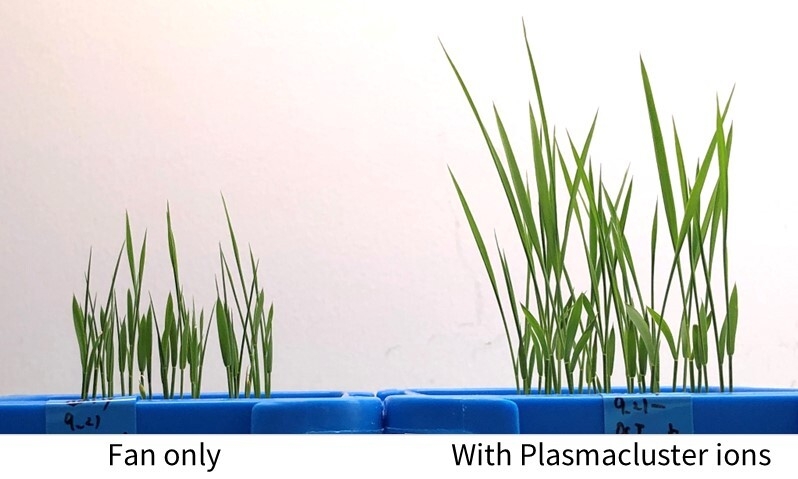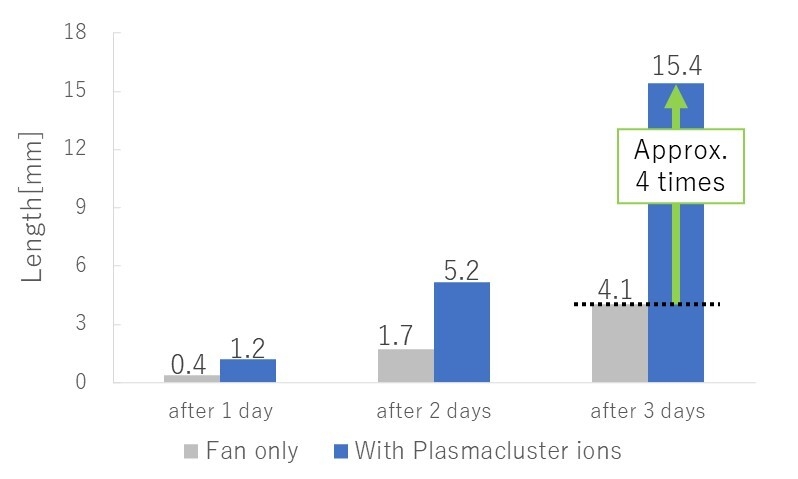Research Activities
Plant Growth Acceleration Mechanism to Which Plasmacluster Technology Contribution Has Been Verified
SHARP Corporation (hereinafter “SHARP”), jointly with Takashi Ikka, Associate Professor, and Hiroto Yamashita, Assistant Professor, at the Faculty of Agriculture, a national university corporation Shizuoka University, studied the mechanisms by which its Plasmacluster technology accelerates the growth of plants, verifying for the first time that Plasmacluster technology contributes to accelerating early stage growth in plants*1.
SHARP, which focused already on the possibility of the effect of Plasmacluster technology in being favorable to plant growth, examined this possibility and verified in 2016 that Plasmacluster technology accelerated the growth of lettuce*2.
In the present study, in order to verify the background mechanism by which Plasmacluster ions contribute to the growth of plants, experiments were conducted using a rice cultivar, with the entirety of its genetic information decoded. The results showed that in case where the plants were exposed to Plasmacluster ions from immediately after seeding, seedlings at an early stage of growth grew four times longer at maximum*3 than early-stage seedlings grown with a fan only, and it was confirmed that the growth accelerating mechanism involved amplification of the activity directed toward energy production (gene expression) by three times at the maximum*4. These results suggested that early-stage plant growth can be accelerated by the exposure to Plasmacluster ions.
The results of the present study demonstrate the potential of Plasmacluster technology to contribute to solving the global challenge of sustainable increase of food productivity.
<Comments from Associate Professor Takashi Ikka (Faculty of Agriculture, Shizuoka University)>
In conducting growth evaluation studies using rice and its genetic analyses, we have partly understood the mechanism by which exposure to Plasmacluster ions accelerates early-stage growth in plants.
This finding leads us to believe that further studies will enable us application of Plasmacluster technology with various other crops.
For example, application of Plasmacluster ions during the period between germination and seedling raising will shorten cultivation periods and reduce production costs, which lead to practical applications in crop cultivation.
Additionally, in present plant factory, leafy vegetables such as lettuce are mainly cultivated in Japan, and in other countries grains such as rice have begun to be cultivated, and these verification results are highly significant for such fields.
I hope the technology will help solve social issues through further studies for practical applications.
*1 Growth from germination through the early stage of vegetative growth. In this study, we evaluated growth within several days after germination.
*2 Growth acceleration effects from Plasmacluster technology were verified in lettuce. https://jp.sharp/plasmacluster-tech/closeup/closeup03/
*3 Calculated from the average level after three days of seeding. (See Fig. 4)
*4 Calculated from the average level for Amy (amylase gene) after one hour of seeding. (See Fig. 5)
● Plasmacluster is a registered trademark of SHARP Corporation.
【Summary of the study to verify the mechanisms of plant growth acceleration with Plasmacluster ions】
● Individuals conducting the study:Takashi Ikka, Associate Professor, Hiroto Yamashita, Assistant Professor, Yoshiki Ishiguro, 2nd year master’s course student (Faculty of Agriculture, Shizuoka University)
● Place of study:Laboratory at the Faculty of Agriculture, Shizuoka University
*Analysis Collaborator:Food analysis laboratory at Shizuoka University
● Test apparatus:Test apparatus equipped with Plasmacluster technology
● Test conditions:
a. Without Plasmacluster ions (fan only)
b. With Plasmacluster ions
● Plasmacluster ion density:Approx. 1,000,000 ions/cm3
● Study method:
・Rice (cultivar: Nipponbare) seeds were placed on a net floating on the water surface in the test apparatus.
・The seeded rice was cultivated under the conditions of using a fan only and with Plasmacluster ions for a given periods of time (days).
・The lengths of seedlings and the degree of gene expression in the embryo (from which roots and leaves develop) were compared.
Gene expression was determined via qRT-PCR*.
Four genes were analyzed: Amy, PK, PDC, ADH**
* qRT-PCR: a method for determining the degree of gene expression by quantitating the products of gene expression.
** Amy:amylase gene OsAmy3D
PK:yruvate kinase gene OsPK1
PDC:pyruvate decarboxylase gene OsPDC2
ADH:alcohol dehydrogenase gene OsADH1
● Results
The following results were obtained in plants exposed to Plasmacluster ions, in comparison with plants grown in fan-only conditions:
[1] The growth of the seedlings was accelerated at an early stage of growth (Fig. 4)
[2] Activity directed toward energy production (gene expression) was amplified at an early stage of growth (Fig. 5).
These results suggest that Plasmacluster technology accelerates early-stage plant growth.






